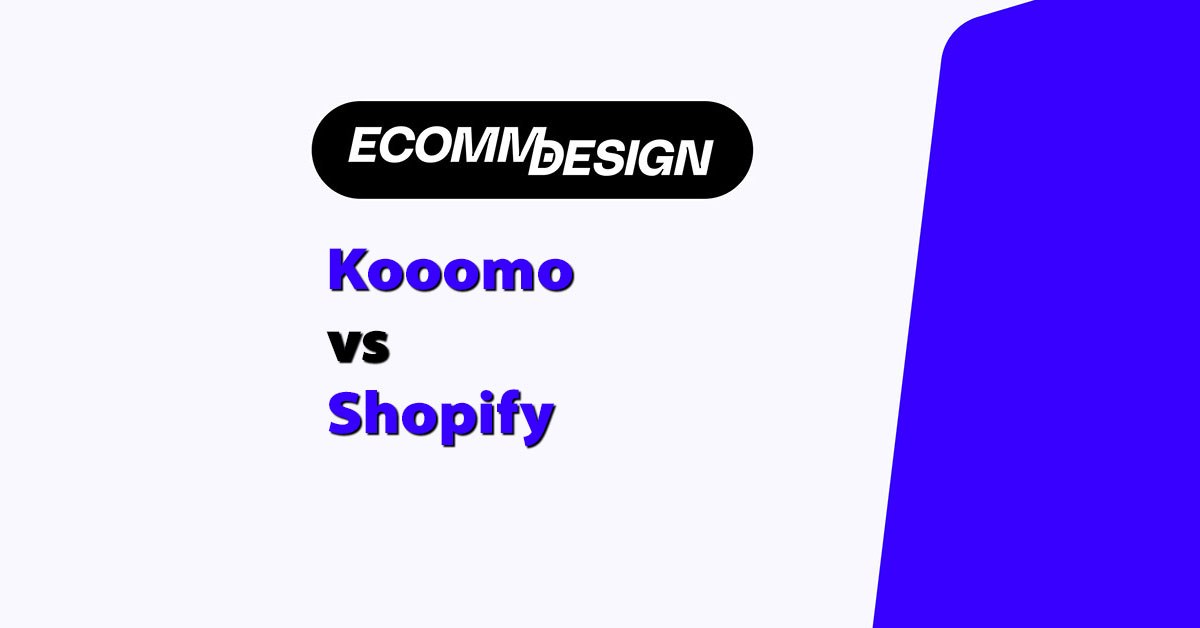
Quick answer: Shopify is the better choice for most businesses, especially if you’re after speed, ease of use, and scalability with a huge app ecosystem.
But if you’re managing multiple storefronts across countries and need true enterprise features with less reliance on third-party apps, Kooomo holds serious weight.
I’ve spent years running ecommerce stores and working hands-on with both platforms. This is a real-world comparison that cuts through the sales fluff.
Let’s get into it.
Quick Verdict
| Feature | Shopify | Kooomo |
|---|---|---|
| Best For | Growing brands, startups | Enterprise retail & international |
| Pricing | Fixed plans from $29/month | Custom pricing based on GMV |
| Free Trial | 3 days + $1/month for 3 months | Request demo only |
| Ease of Use | Extremely user-friendly | Moderate, built for enterprise |
| Templates | 200+ themes | Custom-built designs only |
| Sales Features | Best-in-class + AI tools | Strong native suite |
| App Ecosystem | 8,000+ apps | Fewer integrations, more native |
| Payment Options | 100+ | 30+ |
| SEO & Marketing | Semrush tools, built-in blog | Native SEO, less flexibility |
| Support | 24/7 live chat | Account manager, no live chat |
Pricing: Shopify Is Transparent, Kooomo Is Custom
Shopify starts at $29/month with three core pricing plans. You know exactly what you’re paying for, which makes budgeting simple from day one. There are no surprises.
Here’s the breakdown:
- Basic – $29/month
- Grow – $79/month
- Advanced – $299/month
There’s also Shopify Plus for enterprise clients, which starts at $2,300/month and includes dedicated support, automation tools, and access to exclusive APIs.
That makes it a solid choice for high-growth brands that have outgrown the core plans but aren’t ready for full-blown custom platforms.
Kooomo, on the other hand, doesn’t advertise pricing on its site.
You’ll need to book a demo or sales call to get a quote. Their model is revenue share-based, meaning they charge a percentage of your Gross Merchandise Volume (GMV). From the brands I’ve worked with, pricing typically falls between 1.5% to 3% of monthly sales.
That approach has its pros and cons. On the one hand, it lowers the barrier to entry for large brands that want to avoid fixed monthly overhead.
On the other, your costs scale directly with your revenue, which can add up quickly.
Here’s how the two models compare:
| Platform | Pricing Model | Starting Cost | Scales With Sales | Transparent Pricing |
|---|---|---|---|---|
| Shopify | Fixed subscription | $29/month | No | Yes |
| Shopify Plus | Tiered enterprise plan | $2,300/month | No | Yes |
| Kooomo | Revenue share (GMV %) | Custom | Yes | No |
Kooomo’s pricing often includes more built-in features like hosting, PIM, and OMS, so you’re not paying for multiple tools.
But that’s only a win if you’re using those features fully. Otherwise, you’re locked into a platform with enterprise pricing whether you need the full scope or not.
Verdict: Shopify wins for transparency and entry-level value.
Kooomo only makes financial sense for large-scale retailers doing significant sales volume across regions.
For most brands just starting or scaling online, Shopify gives you a clearer cost structure and more control over your monthly spend.
Sales Features: Both Are Powerful — With a Catch
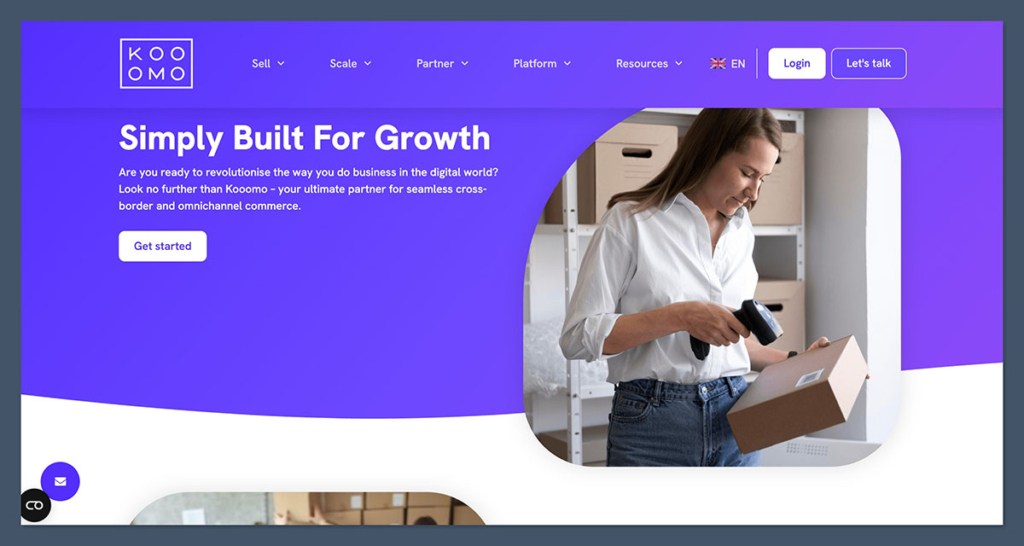
Shopify gives you tools right out of the gate. Everything’s plug-and-play, so you can get your store up and running fast.
It’s built for growth, with sales features designed to work whether you’re a one-person business or a team of 50. You don’t need much technical experience to unlock what Shopify offers.
Here’s what stands out:
Shopify Sales Highlights:
- Abandoned cart recovery on all plans, helping you win back lost sales automatically
- Shopify Magic: AI-generated product descriptions that save hours of manual writing
- Shopify POS: Unified sales experience across online and retail locations
- 100+ payment gateways, including Apple Pay, Google Pay, and PayPal
- Custom discount logic, like BOGO, bulk discounts, and tiered offers
- 8,000+ apps to add upsells, bundles, urgency timers, and subscription models
Shopify’s strength lies in its ecosystem. If a feature isn’t native, it likely exists as an app. That gives you flexibility, but also means some features will come with extra monthly costs or setup time.
Kooomo, meanwhile, focuses more on built-in enterprise-level capabilities. It doesn’t rely heavily on third-party apps.
Instead, the sales infrastructure is natively integrated, making it ideal for retailers managing high volumes, complex supply chains, or omnichannel environments.
Kooomo Sales Highlights:
- Omnichannel inventory syncing across online stores, physical outlets, and marketplaces
- Built-in PIM (Product Information Management) for managing large product catalogs
- Order Management System (OMS) to track orders, returns, and customer service across platforms
- Real-time integrations with Amazon, eBay, Zalando, and more
- Multi-warehouse logic to route orders and optimise fulfilment based on location and stock
- B2B support with custom price lists, tax handling, and access controls
Kooomo’s native systems are powerful, especially if you’re handling thousands of SKUs and selling across multiple countries.
It’s built with operational complexity in mind. But that also means the learning curve is steeper, and onboarding takes longer.
Here’s how they compare:
| Feature | Shopify | Kooomo |
|---|---|---|
| Abandoned Cart Recovery | Yes, built-in | Yes, native |
| POS Integration | Yes (Shopify POS) | Partial (via integrations) |
| Marketplace Integrations | Via apps | Native and real-time |
| Inventory Sync | Via apps or manual | Fully omnichannel |
| PIM / OMS | Third-party required | Built-in |
| B2B Functionality | Available via Shopify Plus | Native |
| Scalability | App-based | Infrastructure-based |
Verdict: Shopify wins for ease and flexibility.
Its app-first model is ideal for fast-growing businesses that want sales tools now, without building everything from scratch.
Kooomo wins for retailers needing tight control over inventory, logistics, and complex operations.
If your sales span continents, channels, and warehouses, Kooomo gives you the framework to scale with precision.
Templates & Design: Shopify Wins by a Mile
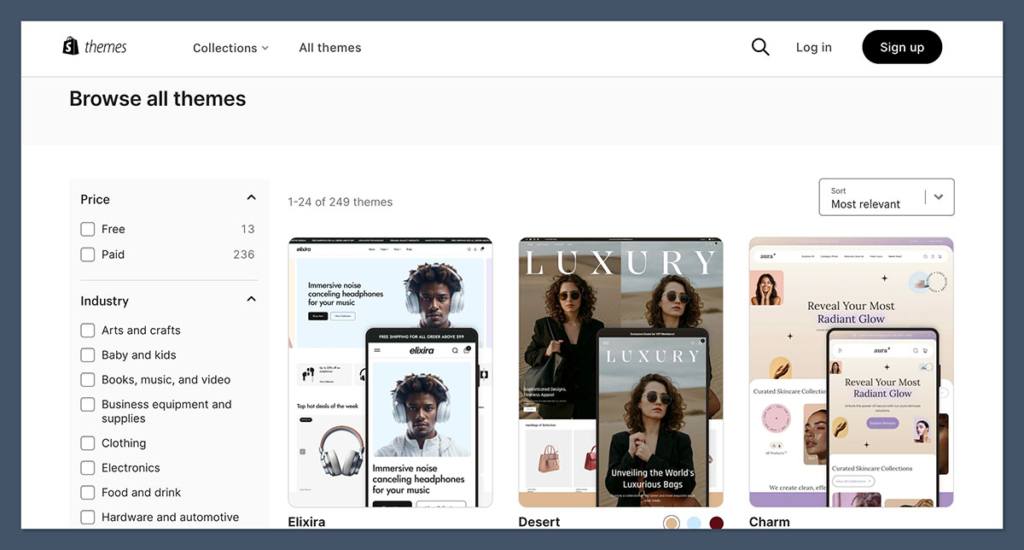
Design is where Shopify shines — especially for non-developers.
Whether you’re launching your first product or rebranding a multi-category store, Shopify makes it easy to build something professional without writing a single line of code.
The platform’s design tools are accessible, intuitive, and built with best practices in mind.
Here’s what you get with Shopify:
- 200+ professionally designed templates
- 13 free themes with modern layouts and mobile optimisation
- Premium themes priced between $100 and $350 (one-time fee)
- Industry-specific themes, including fashion, electronics, food, beauty, and more
- Drag-and-drop customiser, allowing you to edit sections, images, text, and layout without touching code
- Theme Store filters, helping you choose based on product volume, layout style, and features
What makes Shopify’s themes stand out is how they’re structured — speed-optimised, SEO-friendly, and built to convert.
They’re also responsive by default, so your store looks great on desktop and mobile without extra effort.
Kooomo takes a different approach. It doesn’t offer a public template marketplace or drag-and-drop builder. Instead, every storefront is custom-designed, either by Kooomo’s in-house team or your agency or developer.
It’s a solution tailored to complex enterprise needs.
With Kooomo, here’s what design involves:
- Fully bespoke design, developed by partners or internal devs
- No pre-built templates or themes
- CMS integration, allowing for layout changes and content blocks, but with limited front-end editing for non-developers
- Mobile responsive designs, created to spec during build
- Custom UX flows, aligned with specific branding and customer journeys
This setup makes sense for enterprise retailers that need pixel-perfect design and have strict brand guidelines. But it adds time and cost to the process and removes the flexibility that small businesses often need.
Here’s a direct comparison:
| Design Feature | Shopify | Kooomo |
|---|---|---|
| Number of Templates | 200+ | None (custom builds only) |
| Free Themes Available | 13 | No |
| Price of Premium Themes | $100 to $350 (one-time) | Varies by agency or dev scope |
| DIY Customisation | Yes, drag-and-drop | No |
| Developer Needed | No (unless advanced custom work) | Yes, for full site design |
| Mobile Responsive | Yes, default | Yes, through custom dev |
Verdict: Shopify takes the win here.
Shopify is the better choice if you want a great-looking storefront quickly without hiring a full design team. The theme ecosystem, customiser, and built-in flexibility make it ideal for businesses that want control without complexity.
Kooomo works best for brands with the resources to invest in custom development — and the need for deep visual control over every page and flow.
App Store & Integrations: Shopify Dominates
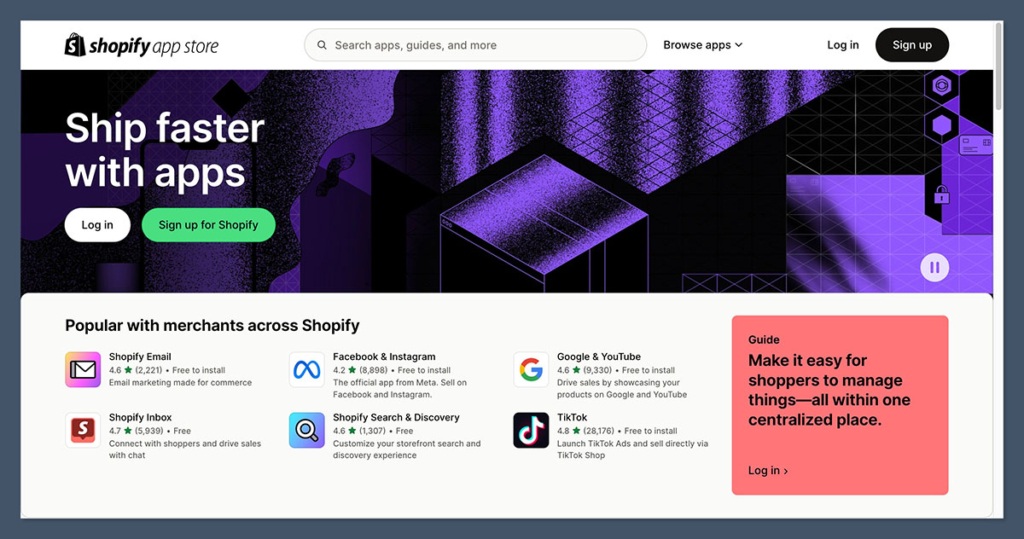
There’s just no competition here. Shopify’s App Store is enormous — and a major reason why so many ecommerce businesses stick with the platform long-term.
Shopify’s model is built on flexibility. Instead of trying to do everything natively, it lets you choose from thousands of tools to shape your store around your business model.
Whether you’re building a subscription box, launching a loyalty program, or syncing inventory with Amazon, there’s likely an app ready to go.
Here’s what Shopify’s app ecosystem looks like:
- 8,000+ apps available in the official Shopify App Store
- Marketing tools like Klaviyo, Omnisend, Mailchimp
- Upsell & bundle apps, including Bold Bundles, ReConvert, and Frequently Bought Together
- Loyalty & rewards programs, such as Smile.io and Yotpo Loyalty
- AI integrations for product descriptions, recommendations, and dynamic pricing
- Analytics & heatmapping tools, like Lucky Orange and Hotjar
- Live chat & customer support apps, including Gorgias, Tidio, and Zendesk
- Shipping, fulfilment, and inventory integrations with services like ShipStation and Easyship
The upside here is that you can scale your tech stack as your store grows. The downside is that it can get expensive. Many apps charge monthly fees, and installing the wrong ones can slow down your store or clutter your dashboard.
But with smart planning, Shopify’s app ecosystem becomes one of your biggest growth assets.
Kooomo takes a different path. Instead of depending on external apps, the platform offers a tightly integrated system where most ecommerce features are already built-in. That includes key enterprise tools like:
Kooomo’s native integration approach:
- PIM (Product Information Management)
- OMS (Order Management System)
- CMS (Content Management System)
- Warehouse management tools
- Multi-channel sync with marketplaces and retail outlets
- Payment, tax, and logistics systems with native European support
- B2B and multi-storefront logic baked into the backend
This works well for larger retailers that want a unified stack without managing a dozen third-party tools. But the trade-off is flexibility.
If you want to experiment with emerging tools, test new marketing software, or connect to niche services, your options are more limited. Integrations usually require custom development or coordination with Kooomo’s team.
Here’s how the two compare:
| Feature | Shopify | Kooomo |
|---|---|---|
| Total Apps/Integrations | 8,000+ third-party apps | Limited, mostly native features |
| Email Marketing | Wide choice via app store | Basic integrations or custom dev |
| Upsells & Bundles | Dozens of apps | Requires manual setup or dev |
| Loyalty Programs | Multiple providers available | Native logic only |
| AI Tools | Many options | Minimal |
| Support for Niche Tools | High | Low |
| Ease of Adding Tools | 1-click installs | Developer or partner assistance |
Verdict: Shopify is more flexible and scalable with third-party tools.
Its app-first ecosystem gives you freedom to grow your store your way, test tools fast, and pivot when needed.
Kooomo works well if you prefer everything native and don’t want to depend on apps.
It’s a solid choice if you value control, stability, and a fully-integrated backend — but that comes at the cost of agility and experimentation.
Payment Options: Transaction Fees Make the Difference
With Shopify, you get access to over 100 payment gateways globally. That includes popular providers like PayPal, Apple Pay, Google Pay, Amazon Pay, and many regional options.
For most merchants, it covers everything you’d need to process online and in-person payments with ease.
Shopify also offers its own native solution — Shopify Payments — which is the key to avoiding extra transaction fees.
If you’re in a supported country, like the US, UK, Canada, Australia, or select European markets, Shopify Payments streamlines the checkout experience and reduces your per-transaction cost.
If you don’t use Shopify Payments, you’ll be charged a transaction fee on top of your payment provider’s fee. Here’s what that looks like:
Shopify’s standard transaction fees (without Shopify Payments):
- Basic: 2.9% + 30¢ per transaction
- Shopify: 2.6% + 30¢ per transaction
- Advanced: 2.5% + 30¢ per transaction
These fees can add up fast, especially for high-volume stores or those operating with tight margins. That’s why Shopify Payments is strongly encouraged if it’s available in your region.
Kooomo takes a different approach. Rather than offering its own payment gateway, it supports about 30 third-party payment providers, including Adyen, Stripe, Klarna, PayPal, Worldpay, and more.
These are integrated directly into the platform and work across multiple countries and currencies.
The biggest benefit? Kooomo doesn’t charge any platform transaction fees — no matter which payment provider you use.
This gives you more freedom to negotiate directly with payment processors and optimise for the best rates, especially if you’re doing volume.
Here’s how the two platforms compare:
| Feature | Shopify | Kooomo |
|---|---|---|
| Native Payment Gateway | Shopify Payments | None |
| Third-Party Integrations | 100+ | ~30 major gateways |
| Platform Transaction Fees | 2.5% to 2.9% + 30¢ (unless native) | None |
| International Payment Support | Yes, with restrictions | Yes, fully supported |
| Buy Now Pay Later (BNPL) | Via providers like Klarna, Afterpay | Via Klarna, PayPal, etc. |
| Multi-currency Checkout | Yes, with Shopify Payments | Yes, across all providers |
Shopify’s gateway is deeply integrated and gives merchants full control over chargebacks, payouts, and payment methods.
But the savings only come if you can use it. If you’re not in a supported country or need more flexibility, those transaction fees become a long-term cost.
Verdict: Kooomo wins on payment flexibility for enterprise.
You can plug in your preferred provider, negotiate your own rates, and avoid platform fees altogether — a serious advantage for global businesses and high-volume retailers.
Shopify is best if you’re using Shopify Payments and based in supported countries.
If that applies to you, the integration is seamless, the rates are fair, and the experience is hard to beat.
SEO and Marketing Tools: Shopify Is More User-Friendly
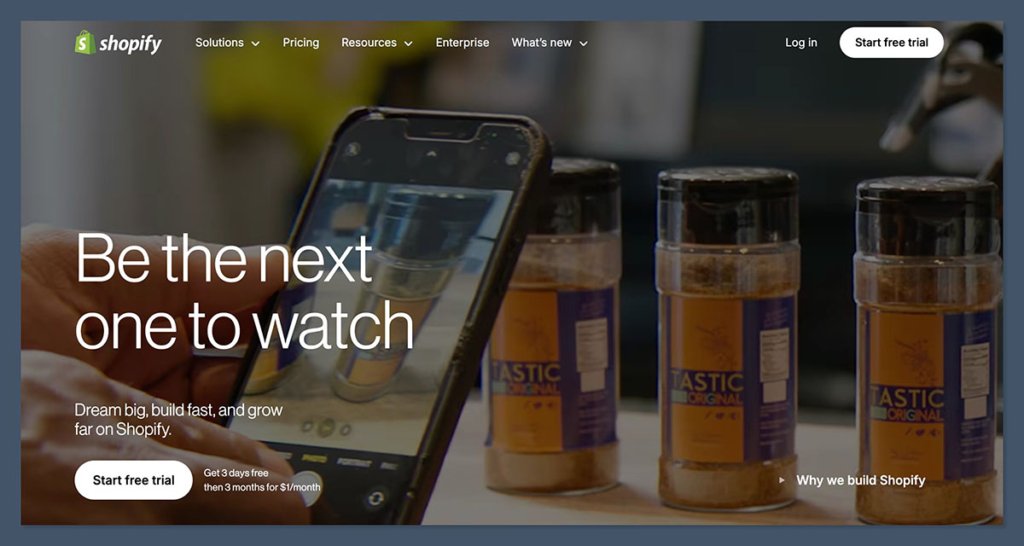
Shopify integrates deeply with modern marketing platforms and SEO tools, making it one of the easiest ecommerce builders to promote and grow your store.
You don’t need to be an expert to get started.
Shopify gives you access to a wide range of built-in tools, plus integrations that automate the heavy lifting for SEO, email marketing, and social ads.
Shopify’s standout marketing and SEO tools:
- Semrush-powered Ecommerce Booster App, which audits your store and recommends actions to improve SEO
- Built-in blog with tagging, categories, and RSS feed
- Structured data markup out of the box, making it easier for search engines to display rich results
- Clean, SEO-friendly URLs, image alt text editing, and fast-loading themes
- Shopify Email, which lets you create, schedule, and send branded email campaigns without paying for another tool
- Social ad integration with Meta Ads (Facebook and Instagram), TikTok Ads, and Google Shopping campaigns
It’s all designed to work together inside your dashboard. You can go from setting up your product pages to running targeted Instagram ads in the same afternoon — no plugins, no code.
Kooomo does support ecommerce SEO and marketing, but it’s more of a technical experience.
The platform includes key SEO elements — like meta fields, canonical URLs, custom redirects, and international targeting — but lacks the automation and simplicity that Shopify offers.
Kooomo’s built-in SEO and marketing tools:
- Meta title and description fields for every page
- Canonical tagging and control over index/noindex status
- 301 redirect management for product and category pages
- Multilingual SEO support, including hreflang tagging
- Google Analytics and Tag Manager integration
- No native email marketing tool — you’ll need to integrate with external platforms or use custom solutions
Kooomo is designed for teams that already know their way around digital marketing or have an agency handling it.
If you’re comfortable setting up analytics, managing SEO tags manually, and running external email campaigns, it’s perfectly functional. But if you want built-in simplicity, it’s not as user-friendly.
Here’s how they compare:
| Feature | Shopify | Kooomo |
|---|---|---|
| SEO Automation | Ecommerce Booster App (Semrush) | Manual, technical setup |
| Built-in Blog | Yes | Yes, but limited styling |
| Email Marketing | Shopify Email | No native tool |
| Social Ads Integration | Facebook, Instagram, TikTok, Google | External setup only |
| Structured Data Support | Yes, out of the box | Yes, technical implementation |
| Multilingual SEO | Yes, with Shopify Markets | Yes, strong native support |
Verdict: Shopify wins again.
It’s faster to launch and scale campaigns with built-in features, simple dashboards, and automated integrations. You don’t need a marketing team to get started.
Kooomo is better suited to enterprise brands with existing marketing infrastructure.
If you have the resources and prefer managing campaigns externally or through agencies, Kooomo offers the backend control you’ll need — just without the marketing shortcuts Shopify provides.
Internationalisation: Kooomo Was Built for This
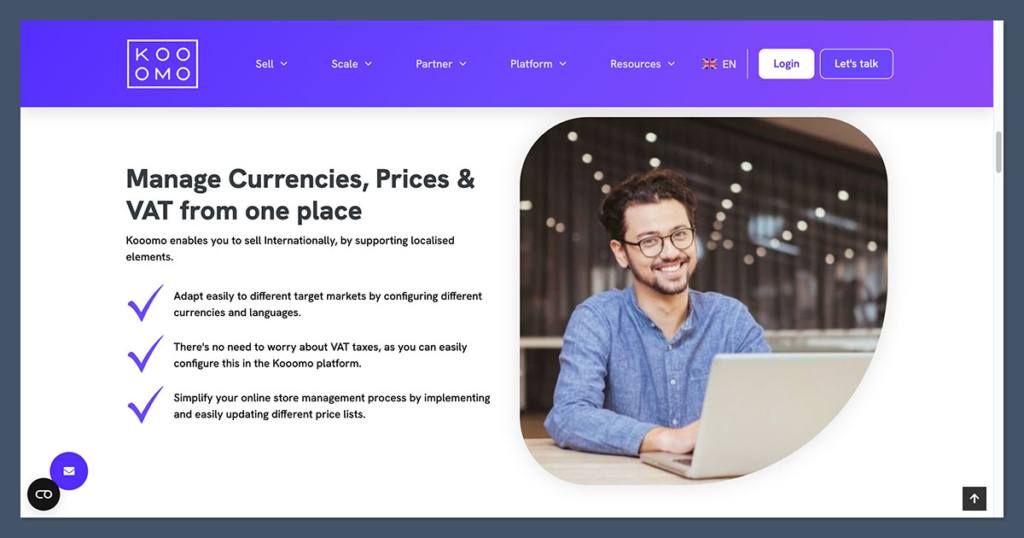
Here’s where Kooomo stands tall. It was designed from the ground up to support international ecommerce — not just as a feature, but as a core part of the platform.
For brands selling across multiple markets, regions, and languages, Kooomo’s native internationalisation features make it easier to stay compliant, local, and scalable.
What Kooomo offers out of the box:
- Multi-language storefronts that adapt to your customer’s browser or location
- Localised content and promotions, allowing country-specific campaigns without duplicating your store
- Multi-currency support with configurable exchange rates and pricing rules
- Automatic tax and VAT handling, based on the shopper’s country
- Custom shipping logic, including localised carriers and delivery timeframes
- Native integrations with global marketplaces, including Amazon, eBay, Zalando, and more across EU, UK, US, and APAC regions
Kooomo is particularly strong in Europe, with features tailored for EU tax compliance, regional logistics, and payment requirements.
You can run multiple storefronts under one backend, each tailored to its own region — ideal for brands that need to scale globally without managing separate systems.
Shopify supports international selling too, and it’s come a long way. Shopify Markets allows merchants to set up country-specific pricing, domains, languages, and payment options.
You can translate content, assign currencies per region, and connect third-party tools for advanced localisation.
Shopify international features include:
- Shopify Markets: a central dashboard for global selling
- Multi-language support with auto-redirect based on region
- Currency conversion, auto-adjusted by location
- Custom domains for different regions
- Tax and duties configuration, including automatic tax collection for EU and US
- Integration with translation apps like Weglot or Langify for full content localisation
However, Shopify’s international setup still requires more configuration.
To get the full experience — especially if you’re selling across multiple regions — you’ll often need additional apps or Shopify Plus, which unlocks more advanced multi-store management.
Here’s a breakdown of the international capabilities:
| Feature | Kooomo | Shopify |
|---|---|---|
| Multi-language Support | Native, automatic | Yes, with translation apps |
| Currency Switching | Native with custom rules | Yes, with Shopify Markets |
| Tax and VAT Support | Built-in, EU-ready | Yes, with auto-calculation |
| Marketplace Sync | Native for EU/US/APAC | Via third-party apps |
| Storefront per Region | Yes, managed in one backend | Yes, on Shopify Plus |
| Region-Specific Promotions | Native campaign logic | Limited without apps |
Verdict: Kooomo wins for global brands.
It’s built for multi-country operations from day one. Everything from currency logic to marketplace integration is already baked into the core platform, which reduces reliance on third-party tools.
Shopify is catching up, but still requires more add-ons to match Kooomo’s native power.
If you’re a brand starting to expand globally and don’t want to juggle too many moving parts, Kooomo offers a more consolidated international toolkit. Shopify can get there — but it takes more time, configuration, and potentially a higher-tier plan.
Ease of Use: Shopify Is Made for Speed
I’ve onboarded brands to both platforms, and there’s no question — Shopify is easier to use. It’s designed to help anyone, even non-technical users, get a store online fast without needing a developer or hours of training.
From signing up to adding your first product, Shopify guides you every step of the way.
The onboarding is smooth, with prompts and checklists that walk you through store setup, payment configuration, product uploads, and design customisation. Everything is where you expect it to be.
Shopify’s ease-of-use highlights:
- Clean and intuitive dashboard with clearly labelled menus
- Onboarding wizard to help set up products, shipping, and payments
- Drag-and-drop editor for pages and homepage sections
- App Store integration in just a few clicks
- Theme customiser with real-time previews and flexible layout options
- Step-by-step tutorials and 24/7 support, available directly from your dashboard
You can go from zero to a functional online store in a single weekend — and that’s not an exaggeration. For solo founders, small teams, or brands launching fast, that level of simplicity is a major win.
Kooomo, on the other hand, takes a more traditional enterprise approach. The interface is designed for teams with ecommerce experience, not necessarily first-timers.
It’s not difficult once you know how to use it, but there’s a learning curve — and setup usually requires support from Kooomo’s team or a certified implementation partner.
Here’s what the Kooomo experience looks like:
- Custom onboarding based on your business requirements
- Training sessions typically included with onboarding
- CMS, OMS, and PIM tools require some operational knowledge to use effectively
- No visual drag-and-drop editor, changes often require developer input
- Advanced configuration panels that may feel overwhelming for beginners
- Multi-store and multi-language controls built for scale, but not simplicity
For enterprise retailers with dedicated ecommerce staff, this setup works well. You get granular control over every aspect of the backend. But for smaller teams or those without in-house devs, Kooomo can feel like overkill for day-to-day tasks.
Here’s a quick side-by-side:
| Feature | Shopify | Kooomo |
|---|---|---|
| Onboarding Process | Guided, self-serve | Custom, with training required |
| Interface Design | Clean and simple | Dense, feature-rich |
| Store Setup Time | 1-2 days | Several weeks |
| Drag-and-Drop Editor | Yes | No |
| Developer Required | Optional (for custom features) | Often needed |
| Best For | New users, fast launches | Enterprise teams, multi-market |
Verdict: Shopify wins.
You can launch a store in a weekend. It’s built for speed, clarity, and self-service — which makes it the best option for most ecommerce operators.
Kooomo takes weeks or longer.
It’s not difficult for trained teams, but it’s not DIY-friendly. Expect a learning curve and setup time, especially if you’re integrating multiple systems or launching in multiple markets.
Support & Community: Shopify Has the Edge
Shopify gives you access to one of the most robust support ecosystems in the ecommerce world. Whether you’re just getting started or scaling to seven figures, help is always a click away.
Support is available 24/7 through multiple channels, and if you ever need guidance beyond the basics, there’s a huge network of partners, freelancers, and developers ready to jump in.
You’re never far from an answer — or someone who can solve a problem quickly.
Here’s what Shopify offers:
- 24/7 live chat for instant support, no matter the time zone
- Detailed support documentation, covering everything from setup to SEO
- Active community forums, with thousands of posts from users and Shopify staff
- A certified partner ecosystem, including agencies, app developers, and consultants
- Freelancer platforms with Shopify specialists available for hire
- Video tutorials, blog content, and webinars covering platform updates and ecommerce strategies
You can solve most issues on your own within minutes, and when something goes beyond your comfort zone, finding the right expert is fast and easy.
Kooomo takes a more personalised, account-based approach to support. You’ll typically work directly with a dedicated account manager or their technical team for implementation and maintenance.
This works well for enterprise businesses that prefer ongoing relationships over transactional support.
Kooomo’s support approach includes:
- Dedicated account manager for enterprise clients
- Email-based support, with scheduled follow-ups
- Tailored onboarding and training, usually with platform walkthroughs
- Technical implementation support, often via Kooomo or certified partners
- Smaller community footprint, with fewer public resources or forums
- Limited on-demand help, no live chat or 24/7 access
While the one-to-one support experience can be helpful for strategic planning or resolving complex issues, it can also slow down day-to-day troubleshooting.
For simple problems or urgent questions, you may need to wait on an email response instead of getting instant answers.
Here’s a side-by-side comparison:
| Feature | Shopify | Kooomo |
|---|---|---|
| Live Chat Support | 24/7 available | Not available |
| Email Support | Yes, with fast response times | Yes, slower response times |
| Account Manager | Only on Shopify Plus | Standard for enterprise clients |
| Partner Network | Extensive global network | Smaller, region-specific |
| Public Knowledge Base | Yes, highly detailed | Limited |
| Community Forums | Yes, highly active | No major community presence |
| Onboarding Support | Self-serve and Plus onboarding | Custom onboarding packages |
Verdict: Shopify wins for support and ecosystem.
You have multiple ways to get help, from live chat to forums to hiring a freelancer within minutes. It’s fast, flexible, and built to support all kinds of users, from beginners to power sellers.
Kooomo works better if you prefer having a dedicated rep.
If you’re managing multiple regions or complex infrastructure and prefer personalised, account-managed support, Kooomo offers a more structured experience — just be prepared for slower response times and fewer community-driven resources.
Final Verdict: Shopify for Most, Kooomo for the Few
If you’re a growing ecommerce business, startup, or even a mid-sized brand, Shopify is hands down the better pick.
It’s designed for speed, flexibility, and simplicity — allowing you to launch fast, manage your store without a technical team, and scale efficiently using an enormous ecosystem of apps, partners, and integrations.
From setup to sales, Shopify streamlines the entire ecommerce process. It’s built for direct-to-consumer brands, subscription models, dropshipping, print-on-demand — and just about every modern ecommerce use case.
If you want to spend your time building your brand instead of managing backend infrastructure, Shopify is the safe and scalable choice.
On the other hand, if you’re managing multiple countries, warehouses, currencies, and teams — and you’ve got the budget — Kooomo gives you enterprise-level ecommerce under one roof. It’s engineered for complexity.
You get a centralised platform with built-in product information management, order management, and native multi-language/multi-currency support. It’s ideal for global retail brands and multi-channel operators that want full control over logistics, pricing, and localised experiences.
Choose Shopify if:
- You want a fast, scalable solution with minimal developer work
- You rely on apps and integrations for marketing, sales, and automation
- You’re running a DTC brand or online-first business
- You prioritise ease of use and fast time to market
- You need access to a large partner and freelancer ecosystem
Choose Kooomo if:
- You’re a retailer doing $5M+ in annual online revenue
- You manage international operations with multiple currencies, regions, and warehouses
- You want a platform with native enterprise features like PIM, OMS, and built-in marketplace integration
- You prefer a fully integrated stack with fewer third-party dependencies
- You have an internal team or agency ready to handle technical implementation and long-term management
Final Thought
Shopify gives you speed, flexibility, and global scale with a relatively low barrier to entry. It’s the best all-around choice for most ecommerce businesses.
Kooomo is a powerful solution for a specific type of business: large, complex, and international. If that’s you, and you need tight control over every part of the ecommerce stack, it delivers — but only if you’ve got the structure and scale to support it.






